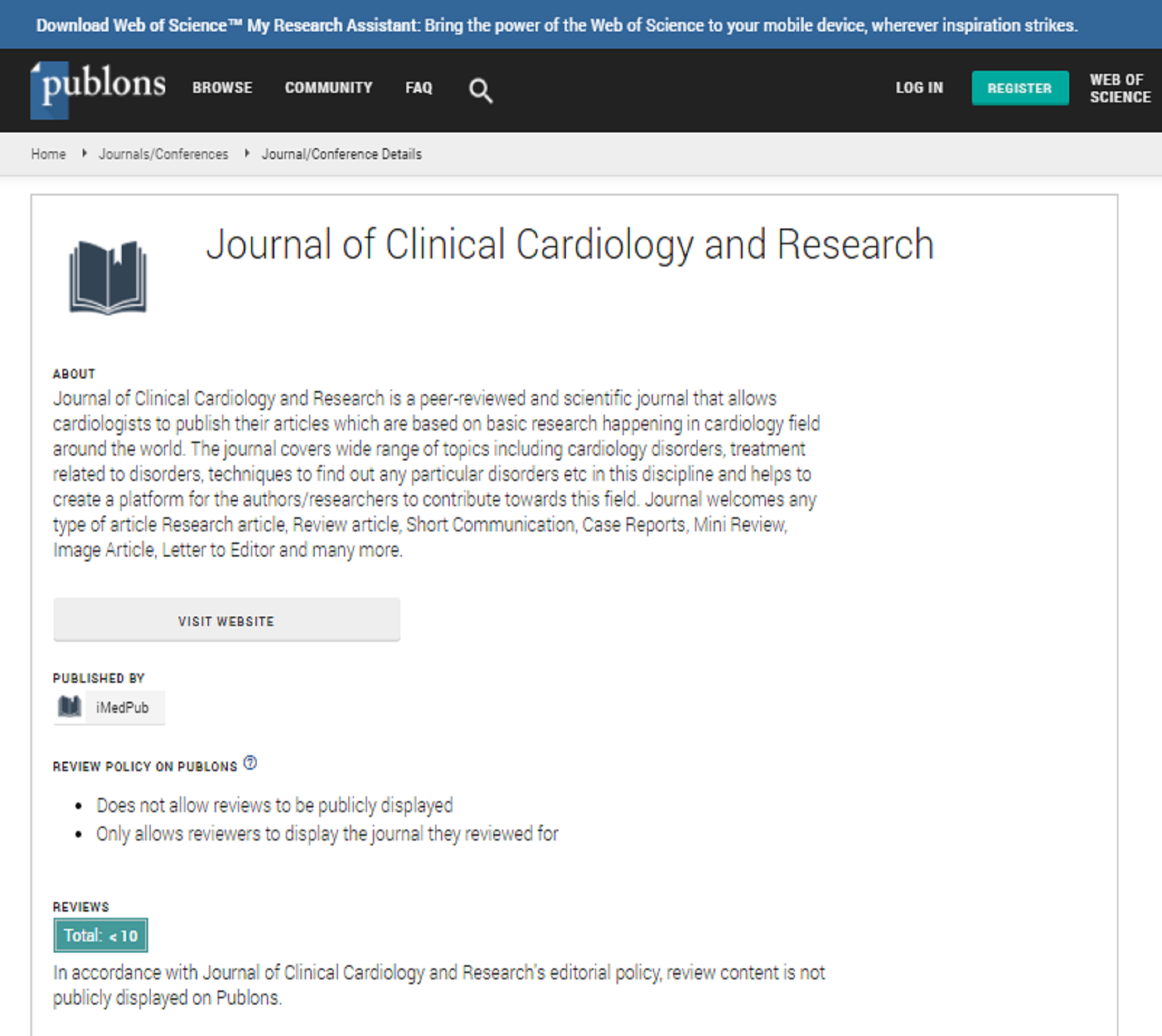Abstract
The Calcium Paradox due to Ca2+/cAMP Interaction and Antihypertensive Pharmacotherapy: New Avenues for Drug Development
Introduction: Since 1970´s, many clinical research have described that prescription of Ca2+ channels blockers (CCBs) for hypertensive patients, such as verapamil and nifedipine, produces discount in peripheral vascular resistance and arterial strain due to vasodilation, resultant of discount of Ca2+ inflow thru plasmalemal L-type voltage-activated Ca2+ channels (VACC) in clean muscle cells, however additionally produces expand in plasma catecholamines stages and coronary heart rate, common signs and symptoms of sympathetic hyperactivity.. Despite the dangers of antihypertensive therapy, these unfavorable consequences of L-type VACC blockers had been originally attributed to autonomic alter reflex of arterial pressure. However, numerous experimental research carried out in 1970´s, with the aid of analyzing the outcomes of L-type VACC blockers in easy muscle richly inervated by way of sympathetic neurons (rodent vas deferens) submitted to electrical area stimulation (EFS), confirmed that these blockers should produce twin impact on sympathetic neurotransmission. In excessive concentrations (>1 μM), L-type VACC blockers totally inhibited sympathetic EFS-contractions due to blockade of Ca2+ inflow in easy muscle cells, however satirically accelerated these contractions in low concentrations (<1 μM), suggesting that different working precept than solely autonomic adjusting reflex is concerned in this paradoxical event. However, the critical mechanisms concerned in this paradoxical impact of L-type VACC blockers remained doubtful at some point of nearly forty years. In a learn about posted in 2013 in Cell Calcium, we tested that the paradoxical sympathetic hyperactivity produced by way of Ltype VACC blocker, named by way of us as “calcium paradox”, is resultant of interference produced with the aid of these blockers on the signaling pathways interplay mediated through Ca2+ and cAMP (Ca2+/cAMP interaction. We confirmed that simultaneous administration of L-type VACC blockers (verapamil) with capsules which produce extend of cytosolic cAMP attention ([cAMP]cenhancers), such as rolipram, IBMX and forskolin, superior sympathetically-mediated contractions of vas deferen. In addition, this enhancement of contraction was once decreased with the aid of reducing [cAMP]c precipitated through adenylyl cyclase (AC) inhibition (SQ 22536), or diminution of Ca2+ storage from endoplasmic reticulum (ER) with the aid of thapsigargin, revealing the involvement of Ca2+ mobilization from ER in this response. Our research confirmed that paradoxical extend of sympathetic recreation produced via Ca2+ channels blockers, used in antihypertensive therapy, effects from increment of neurotransmitters launch from secretory response of postganglionic sympathetic neurons due to its interference on the Ca2+/cAMP interaction. Thus, discount of Ca2+ inflow in these cells by using verapamil and different Ca2+ channels blockers (in low concentration) will increase AC activity, and [cAMP]c, due to minimize of [Ca2+]c. It was once confirmed that 5 and 6 isoforms of AC are worried in this AC-inhibition through Ca2+. The [cAMP]c increment reasons expand of cAMP-stimulated Ca2+-release from ER, that in turn, stimulates exocytotic manner due to decorate of secretory vesicles recruitment, and docking, to the plasma membrane, priming of fusion machinery, and fusion of vesicles with the plasma membrane. Theoretical mannequin of Ca2+/cAMP interplay in secretory cells proposed with the aid of Bergantin et al. and Caricati-Neto et al. [8] illustrates how secretory responses of the neurons and neuroendocrine cells can be modified through pharmacological modulation of intracellular tiers of Ca2+ and/or cAMP (Figure 1). This proposement is reforcing the speculation that Ca2+/cAMP interplay performs an vital position in the sympathetic activity, by means of regulating secretory response of sympathetic neurons, and adrenal chromafin cells. In addition, these pharmacological manipulations of the Ca2+/cAMP interplay ought to have vital implications for antihypertensive pharmacotherapy. Implications of Ca2+/cAMP Interaction for Antihypertensive Pharmacotherapy: New Avenues for Drug Development Grossman and Messerli [1] by way of inspecting Medline database, from 1975 to 1996, determined sixty This work is partly presented at 2 nd World cardiology Experts Meeting at September 21-22, 2020, Webinar Vol.3 No.1 Extended Abstract Journal of Clinical Cardiology and Research 2020 three scientific research involving 1,252 hypertensive sufferers highlighting sympathetic hyperactivity caused through acute and continual prescrition of L-type VACC blockers, and different publications in some hypertensive sufferers that nifedipine has been suggested to result in sympathetic activation, and a paradoxical increment of blood strain. Then, whether or not this “calcium paradox” due to Ca2+/cAMP interplay is concerned in this sympathetic hyperactivity in hypertensive sufferers deserves unique attention. Indeed, L-type VACC blockers like verapamil, and analogous, have been notably prescribed to minimize blood stress in hypertensive patients, specially in aggregate with different tablets for assuaging angina or cardiac arrhythmias. In the subject of drug interaction, we may want to additionally conclude that a remedy involving the blended prescription of VACC blockers with capsules which extend [cAMP]c ought to be carried out cautiously in hypertensive sufferers with neurological/psychiatric issues, thinking about the participation of sympathetic transmission in modulating vascular tone via discharging neurotransmitters into the vasculature. Then, the pharmacological dealing with of the Ca2+/ cAMP interplay should characterize a manageable deleterious impact for antihypertensive remedy due to extend in sympathetic hyperactivity of the cardiovascular system. Conclusion: Ca2+/cAMP interplay is implicated on the rules of secretory response from sympathetic neurons and adrenal chromafin cells, and adjustments of this interplay may want to be implicated in sympathetic hyperactivity of hypertension due to exacerbation of catecholamines, and purines release, from sympathetic neurons and adrenal chromafin cells, which stimulates vasconstriction and reduces vasodilation, dramatically growing peripheral vascular resistance, and arterial pressure. These findings might also have vital have an impact on for antihypertensive pharmacotherapy due to a couple of mechanisms concerned in sympathetic hyperactivity related to arterial hypertension, and plausible chance worried in drug interplay between VACC blockers and pills which enlarge [cAMP]c. New antihypertensive pharmacotherapy techniques should be developed in future to attenuate the cardiovascular chance related with drug interference on the Ca2+/cAMP interplay in sympathetic neurons, and adrenal chromafin cells. In conclusion, this interplay ought to be a novel therapeutic goal for drug development.
Author(s): Leandro Bueno
Abstract | PDF
Share This Article
Google Scholar citation report
Journal of Clinical Cardiology and Research peer review process verified at publons
Abstracted/Indexed in
- Google Scholar
- Publons
Open Access Journals
- Aquaculture & Veterinary Science
- Chemistry & Chemical Sciences
- Clinical Sciences
- Engineering
- General Science
- Genetics & Molecular Biology
- Health Care & Nursing
- Immunology & Microbiology
- Materials Science
- Mathematics & Physics
- Medical Sciences
- Neurology & Psychiatry
- Oncology & Cancer Science
- Pharmaceutical Sciences



